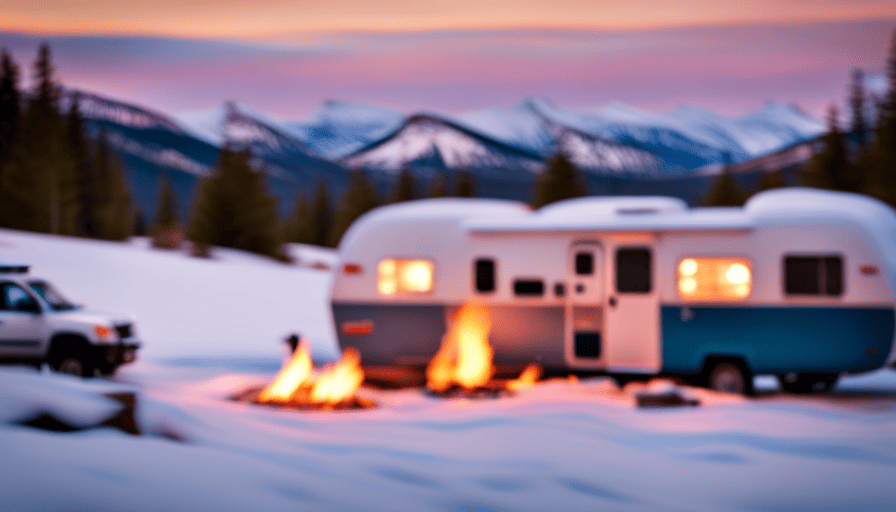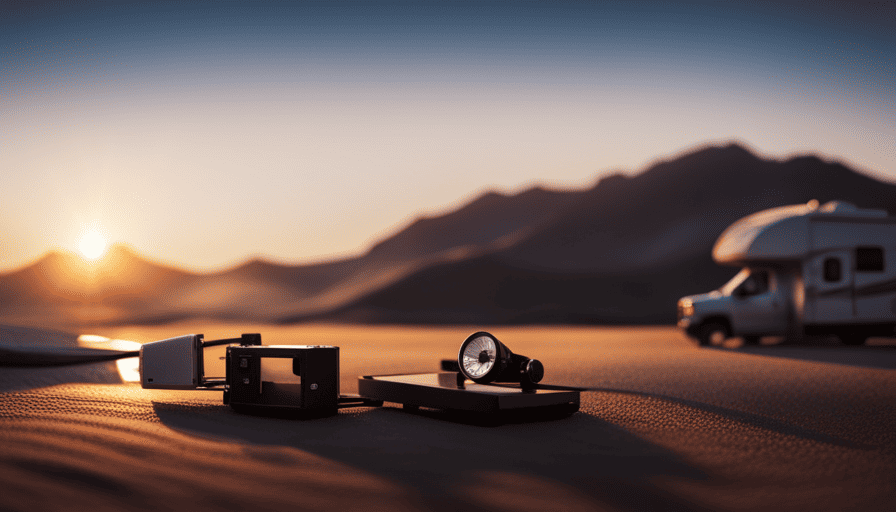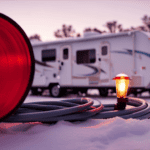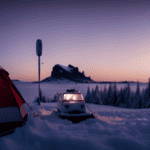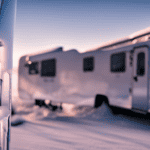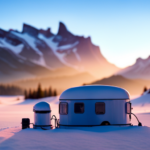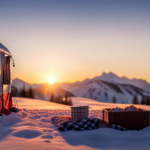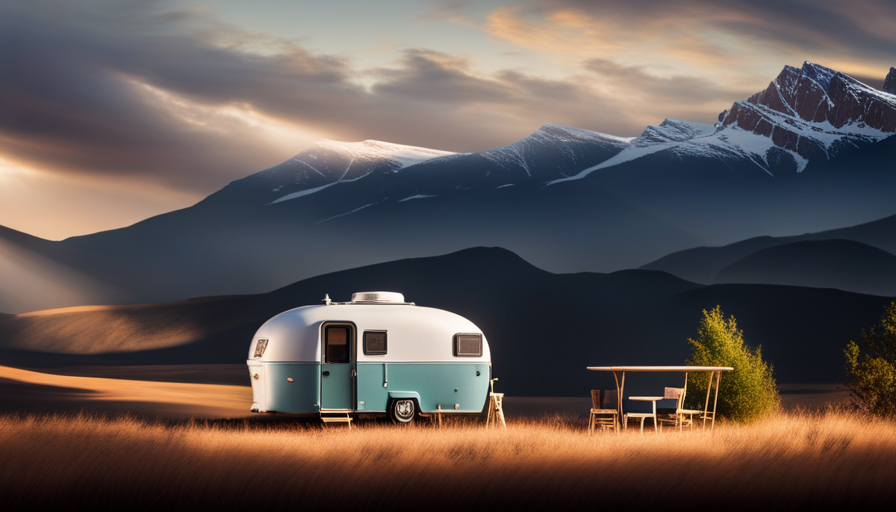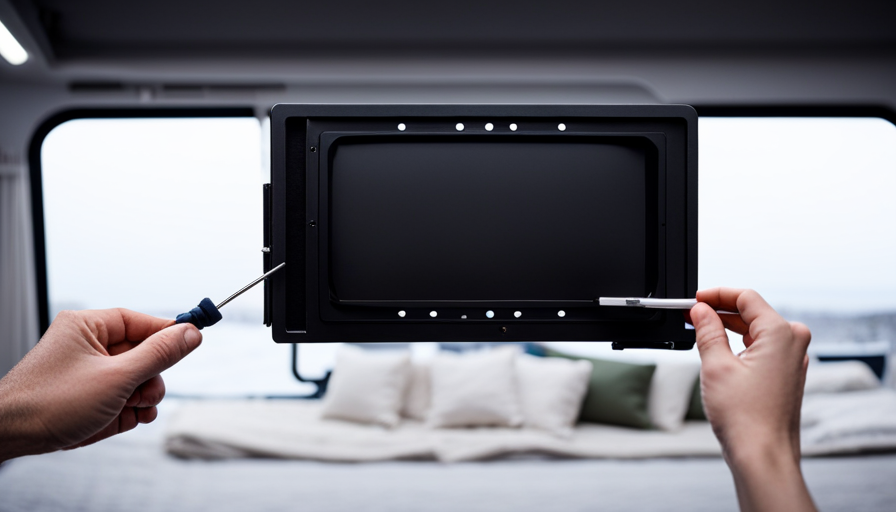Did you know that cold temperatures can cause your camper’s water system to freeze, leaving you without running water during your camping trip? This can be a frustrating and inconvenient situation that all campers want to prevent.
But fear not, because I’m here to share some practical tips and tricks to keep your camper water from freezing and ensure a smooth and enjoyable camping experience.
In this article, I’ll guide you through various methods to prevent freezing, from insulating your water pipes and using a heated water hose to installing a tank heater and using heat tape on external pipes. I’ll also share advice on how to keep your camper warm and keep the water running.
Additionally, I’ll discuss the benefits of using a portable water heater and adding antifreeze to your water system.
By implementing these strategies and using insulating covers for water tanks, you can protect your camper’s water system from freezing and avoid the hassle of dealing with frozen pipes.
Let’s dive in and learn how to keep your camper water flowing even in the coldest of temperatures.
Key Takeaways
- Insulate water pipes using methods like foam pipe insulation or heat tape to prevent freezing.
- Consider using heated water hoses and tank heaters to efficiently prevent water from freezing in a camper.
- Regularly monitor and maintain heat tape on external pipes to ensure proper functionality.
- Use portable heaters and insulating covers for water tanks to keep the camper warm and maintain water temperature.
Insulate Your Water Pipes
To keep your camper water from freezing, you’ll want to make sure to insulate your water pipes so you can have worry-free camping adventures. Preventing frozen water pipes in campers is essential, as it can cause a lot of inconvenience and potential damage.
Luckily, insulating your water pipes is a relatively simple and effective solution. Firstly, you’ll need to locate all the water pipes in your camper. These are usually found underneath the camper or inside cabinets. Once you’ve identified them, you can start the insulating process.
One popular method is to use foam pipe insulation. This insulation comes in various sizes and can easily be cut to fit your pipes. Simply slide the insulation over the pipes and secure it with zip ties or duct tape.
Another option is to use heat tape. This tape is designed to wrap around the pipes and provide a constant source of heat. Make sure to follow the manufacturer’s instructions when installing heat tape to ensure proper usage and safety.
Insulating your water pipes is a crucial step in preventing frozen pipes in campers. However, it’s important to remember that this is just one part of the solution.
In the subsequent section, we’ll discuss another method to keep your camper water from freezing: using a heated water hose.
Use a Heated Water Hose
Try using a heated water hose to prevent your camper’s water from turning into solid ice, and you’ll be amazed to know that it can save you up to 80% on energy bills compared to traditional heating methods! Here are three advantages of using a heated water hose:
-
Efficient Heating: A heated water hose is specifically designed to maintain a constant temperature, preventing the water inside from freezing. It uses a built-in heating element that warms the hose from within, ensuring a steady flow of water even in freezing temperatures. This efficient heating mechanism reduces energy consumption, making it a cost-effective solution for keeping your camper’s water flowing.
-
Easy Installation: Installing a heated water hose is a breeze. Simply connect it to the water source and plug it into a power outlet. The hose automatically heats up, and you can start using it right away. Its flexibility allows for convenient placement and storage, making it ideal for camping trips.
-
Versatility: Heated water hoses are not only useful for preventing water from freezing in your camper. They can also be used in a variety of other settings, such as RVs, livestock watering systems, and even boats. Their versatility makes them a valuable investment for any outdoor enthusiast.
While a heated water hose is an excellent option, there are alternatives to consider. In the next section, we’ll explore how to install a tank heater to further protect your camper’s water system.
Install a Tank Heater
Installing a tank heater ensures that your camper’s water system remains warm and functional, no matter how chilly the weather gets. The tank heater installation process is relatively straightforward, and it provides several benefits.
First and foremost, it prevents the water in your camper’s tank from freezing, which is crucial for those cold winter camping trips. It also helps to maintain a consistent water temperature, so you don’t have to worry about taking cold showers or washing dishes with freezing water.
To install a tank heater, start by draining the water from the tank and disconnecting any power sources. Then, carefully attach the tank heater to the tank using the provided brackets or straps. Make sure to follow the manufacturer’s instructions and secure the heater tightly to prevent any leaks.
Once installed, the tank heater will automatically regulate the temperature, keeping your water system warm even in the coldest conditions.
Using a tank heater has many benefits, including peace of mind knowing that your water won’t freeze and your camper’s water system will remain functional. It’s an investment that can greatly improve your camping experience, especially during the winter months.
In the next section, we will discuss another effective method to prevent freezing by using heat tape on external pipes.
Use Heat Tape on External Pipes
Ensure that the lifeblood of your camper’s plumbing system remains warm and flowing by wrapping heat tape around the external pipes, like a cozy blanket protecting them from the icy grip of winter. Heat tape installation is a simple and effective way to prevent your camper’s pipes from freezing and bursting during cold temperatures. Here are some key points to consider when using heat tape:
-
Choose the right type of heat tape: There are different types of heat tape available, so make sure to choose one that’s specifically designed for external pipe insulation. Look for a tape that’s suitable for the size and material of your camper’s pipes.
-
Properly wrap the heat tape: Start by cleaning the pipes to ensure good adhesion. Then, carefully wrap the heat tape around the pipes, making sure there aren’t any gaps or overlapping areas. Secure the tape with zip ties or electrical tape to keep it in place.
-
Monitor and maintain the heat tape: Regularly check the heat tape for any signs of wear or damage. Replace it if necessary to ensure proper functionality.
-
Consider alternative pipe insulation methods: While heat tape is an effective solution, it may not be suitable for all situations. In some cases, using foam insulation sleeves or heat cables may be a better option.
By following these steps, you can protect your camper’s external pipes from freezing and keep the water flowing smoothly.
Now, let’s move on to the next section about keeping the camper warm.
Keep the Camper Warm
Get cozy in your camper by implementing simple methods to maintain a warm and comfortable environment. One effective way to keep the camper warm is by using portable heaters. These heaters are designed to provide warmth in small spaces and can easily be moved around to different areas of the camper.
Portable heaters come in various sizes and types, including electric and propane heaters. Electric heaters are convenient because they can be plugged into an electrical outlet, while propane heaters use a propane tank for fuel. Both options are efficient and can quickly heat up the camper, ensuring a comfortable temperature inside.
When using portable heaters, it’s important to follow safety precautions. Make sure to keep flammable objects away from the heater and never leave it unattended. Additionally, ensure proper ventilation to prevent the buildup of carbon monoxide. Opening a window or using a carbon monoxide detector can help maintain a safe environment.
To further prevent the water in the camper from freezing, another option is to use a space heater in the water compartment. This will provide additional heat and help keep the water from freezing.
With these simple methods, you can enjoy a warm and cozy camper experience even in cold weather.
Use a Space Heater in the Water Compartment
Investigating whether using a space heater in the water compartment can effectively prevent freezing is worth considering for a warmer camping experience.
When it comes to keeping the camper warm, utilizing a space heater in the water compartment can be a practical solution. However, before deciding to use this method, it’s important to take into account the energy consumption and safety considerations.
Using a space heater in the water compartment requires electricity, and it’s essential to assess the energy consumption. It’s recommended to choose a space heater that’s energy-efficient and has adjustable settings to regulate the heat output. By monitoring and managing the usage, it’s possible to minimize the impact on the camper’s overall energy consumption.
Safety should always be a priority when using a space heater in any confined space, including the water compartment. It’s crucial to ensure proper ventilation to prevent carbon monoxide build-up. Installing a carbon monoxide detector is highly recommended to provide an extra layer of safety. It’s also important to follow the manufacturer’s instructions and never leave the space heater unattended.
Considering the energy consumption and safety considerations, using a space heater in the water compartment can be an effective way to keep the camper warm. However, it’s crucial to complement this method with other strategies, such as keeping the water running, to further prevent freezing.
Keep the Water Running
To effectively prevent the water from freezing, it’s important to make sure the water is continuously flowing. This can be achieved through various water circulation techniques that help in winterizing water systems. By keeping the water moving, you can avoid the formation of ice and ensure a steady supply of water during cold camping trips.
One effective way to keep the water running is to install a recirculation pump in your camper’s water system. This pump continuously circulates the water, preventing it from sitting still and freezing. It’s a practical solution that requires minimal effort and investment.
Another option is to use an electric heating pad or tape specifically designed for water systems. These devices generate heat, keeping the water warm and preventing freezing. They can be easily installed and controlled to provide just the right amount of warmth needed.
To further engage the audience, let’s look at a table comparing different water circulation techniques:
| Water Circulation Techniques | Pros | Cons |
|---|---|---|
| Recirculation pump | Easy installation, continuous water flow | Requires electricity |
| Electric heating pad/tape | Provides heat, simple installation | May require monitoring and adjustments |
By implementing these water circulation techniques, you can ensure a constant supply of water in your camper during freezing temperatures. However, if you’re looking for a more powerful solution, the next section will discuss using a portable water heater.
Use a Portable Water Heater
Using a portable water heater can be a convenient solution for ensuring a continuous supply of hot water in your camping trips. Here are some reasons why a portable water heater is a great option for campers:
-
Portability: A portable water heater is designed to be lightweight and compact, making it easy to transport and set up at your campsite.
-
Versatility: Whether you prefer a gas or electric water heater, there are options available to suit your needs. Gas water heaters are great for off-grid camping, while electric water heaters can be used with a power source.
-
Convenience: With a portable water heater, you can enjoy a hot shower wherever you are. No more waiting in line for shared campground showers or dealing with cold water.
-
Temperature control: Most portable water heaters allow you to adjust the temperature according to your preference, ensuring a comfortable shower experience.
Now that you know the benefits of using a portable water heater, it’s time to learn about another method to prevent water from freezing in your camper: adding antifreeze to your water system.
Add Antifreeze to Your Water System
After exploring the option of using a portable water heater to prevent camper water from freezing, let’s now dive into another effective method: adding antifreeze to your water system. This is a tried and true technique that many experienced campers swear by.
The benefits of using antifreeze in water systems are numerous. Firstly, it lowers the freezing point of water, ensuring that your pipes and tanks remain in good condition even in freezing temperatures. This means that you can continue to have access to water throughout your camping trip without worrying about any damage.
When using antifreeze in your camper water system, there are a few tips to keep in mind. Firstly, make sure to choose a non-toxic antifreeze specifically designed for RVs and campers. This ensures the safety of both your water system and the environment. Secondly, follow the manufacturer’s instructions carefully when adding antifreeze to your system. It’s important to use the right amount and to properly flush the system when you’re done.
By utilizing antifreeze in your camper water system, you can enjoy the peace of mind that comes with knowing your water supply is protected from freezing temperatures.
Now, let’s move on to the next section where we will discuss the use of insulating covers for water tanks.
Use Insulating Covers for Water Tanks
Insulating covers can effectively protect water tanks from extreme temperatures, with studies showing that they can reduce heat loss by up to 80%. When camping in freezing temperatures, it is crucial to take measures to prevent your camper’s water from freezing, and using insulating covers is a practical solution. These covers provide an extra layer of insulation, helping to maintain the temperature of the water inside the tanks.
There are different types of insulating covers available in the market, each with its own benefits. Here is a comparison table that can help you choose the right one for your camper:
| Type of Insulating Cover | Benefits |
|---|---|
| Foam Insulation | Provides excellent insulation and is easy to install. It is also lightweight and durable. |
| Reflective Insulation | Reflects heat back into the tank, preventing heat loss. It is also resistant to moisture and mold. |
| Thermal Blankets | Offers superior insulation and is resistant to extreme temperatures. It is also easy to clean and maintain. |
No matter which type of insulating cover you choose, it is important to ensure a proper fit and seal to maximize its effectiveness. Regularly inspect and maintain the covers to ensure they remain in good condition.
By using insulating covers for your water tanks, you can effectively prevent freezing and ensure a steady supply of water during your camping adventures in cold weather. Stay prepared and enjoy your camping experience without worrying about frozen water!
Frequently Asked Questions
How can I prevent my water pipes from freezing in my camper?
To prevent frozen camper pipes and insulate your camper water system, there are a few steps you can take. First, make sure to drain all the water from the system when you’re not using it. This will eliminate any water that could freeze and cause damage.
Additionally, you can insulate the pipes using foam pipe insulation or heat tape. These measures will help keep your camper water system functioning properly even in cold temperatures.
What is the best way to keep the water in my camper from freezing during cold weather?
During cold weather, I’ve found that insulating techniques work best to keep the water in my camper from freezing. I wrap the water storage tanks with insulation blankets or foam sleeves to provide an extra layer of protection.
Additionally, I use alternative methods like installing a heated water hose or using electric heating pads specifically designed for RV water systems. These practical solutions have helped me ensure a continuous water supply even in freezing temperatures.
Are there any specific products or devices that can help keep camper water from freezing?
There are several products and insulation options available that can help keep camper water from freezing. One option is to use insulated water hoses, which are designed to prevent freezing in cold temperatures.
Another option is to install a heated water hose, which uses a built-in heating element to keep the water flowing.
Additionally, insulating the water tank and pipes with foam insulation can also help prevent freezing.
These products and insulation options are practical solutions to ensure your camper water stays unfrozen during cold weather.
Is it safe to use a space heater in the water compartment of my camper to prevent freezing?
Using a space heater in the water compartment of your camper to prevent freezing may not be safe. Safety concerns arise due to the potential for fire hazards and electrical issues. It’s crucial to prioritize safety when dealing with heating devices in confined spaces.
Instead, consider alternative methods such as insulating the water compartment, using heated water hoses, or installing a tank heater. These methods are safer and will effectively prevent freezing without putting you and your camper at risk.
Can I use antifreeze in my camper’s water system to prevent freezing?
Using antifreeze in your camper’s water system is an alternative method to prevent freezing. There are both pros and cons to consider.
The main advantage is that antifreeze is specifically designed to withstand extremely low temperatures, ensuring your water system remains protected. However, it’s important to note that antifreeze is toxic and should be handled with care. Additionally, the use of antifreeze may require flushing and cleaning of the water system before using it again.
Conclusion
In conclusion, keeping camper water from freezing is crucial for a successful and enjoyable camping experience. By taking the necessary precautions such as insulating pipes, using a heated water hose, and installing a tank heater, you can ensure a constant supply of water even in freezing temperatures.
Just like how we must protect our physical resources, we must also safeguard our emotional well-being. Just as we insulate our pipes, we must insulate our hearts from the cold winds of negativity. By taking these practical steps, we can create a warm and harmonious environment within ourselves and in our surroundings.

